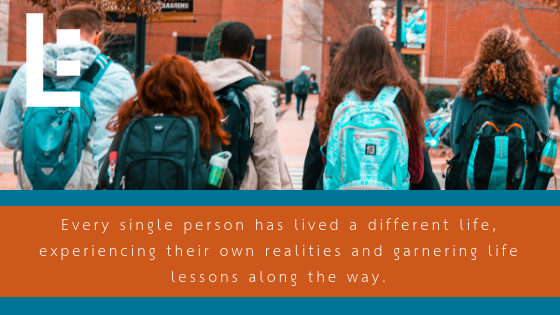Teaching Tolerance in Secondary Classrooms
Much of what goes on in our world makes its way into our classrooms in some form or another. In this sense, many view classrooms or schools in general as microcosms—mini representations of society. Ask any teacher, and tolerance is likely not part of their curriculum. However, much like with a productive and stable society, tolerance plays an essential role in creating a welcoming and productive classroom environment. Fostering a positive environment is no easy task, especially when our world is in the midst of such grave negativity. Tolerance in the classroom takes time, patience, practice, and reflection.
Remind students that everyone they meet knows something they don’t. Whether rich, poor, black, white, gay, straight, foreign, or not—every single person has lived a different life, experiencing their own realities and garnering life lessons along the way. Instead of viewing someone’s vastly different experiences as weird or wrong, students should be reminded of the value that varying experiences, perspectives, and lifestyles offer.
Change the language of the classroom when it comes to discussing differences. To avoid “othering” certain groups, encourage neutral or positive ways to address differences. Instead of allowing students to use weird, odd, strange, unusual, etc. to describe people, groups, or customs, a positive classroom environment should be one where words like unique, unfamiliar, uncommon, fascinating, diverse, various, or distinctive are used.
Approach confrontation with logical questions. Since students bring differing experiences and opinions into the classroom, occasional clashes are to be expected. When this occurs, teachers can use these opportunities as teachable moments by addressing the issue with open, honest, logical conversations. Guided or rhetorical questions also allow students to reflect on their own perspectives and how they react to others. For instance, a teacher might ask, “In what way does his/her different opinion or belief threaten yours?” “Is there a reason that their differences affect you?” “How can we focus more specifically on ourselves and less on how others behave, speak, learn, etc.?” “What do you think you know about certain people? What if you took a moment to consider where these beliefs/opinions come from?” “Saying that someone’s choices are wrong do not necessarily make yours right.” “This argument could simply be de-escalated by considering it a difference of opinions.” All of these talking points prompt students to reflect on their own belief systems while maintaining an open mind towards others.
Learn how to recognize your own implicit bias. This is often a difficult practice for teachers—we aim to be impartial, objective, open-minded educators that provide equal opportunities to all of our students. Therefore, recognizing, questioning, and shedding light on our own innate judgments goes against what we are working towards in the classroom. It also summons feelings of discomfort by forcing us to identify our own stereotypes and belief systems. As difficult and uncomfortable as this may be, we must address our own biases before we can ask students to do the same. To foster tolerance, there must first be a foundation of understanding—what better way than to begin with our own reflections?
Create opportunities for students to learn about one another on deeper, more meaningful levels. Free writes, warm up topics, discussion starters, and icebreakers are all optimal opportunities to help build a solid, positive rapport in the classroom. Ask students to respond to questions such as:
- What is one way that your family likes to celebrate an important accomplishment?
- What types of traditions are unique to your family/community?
- Do you have any rituals, superstitions, good luck charms, etc.?
- Where do most family gatherings happen?
- What important memory from your childhood makes you smile?
- What does your typical Saturday look like?
- What do you like to do on a snow day?







